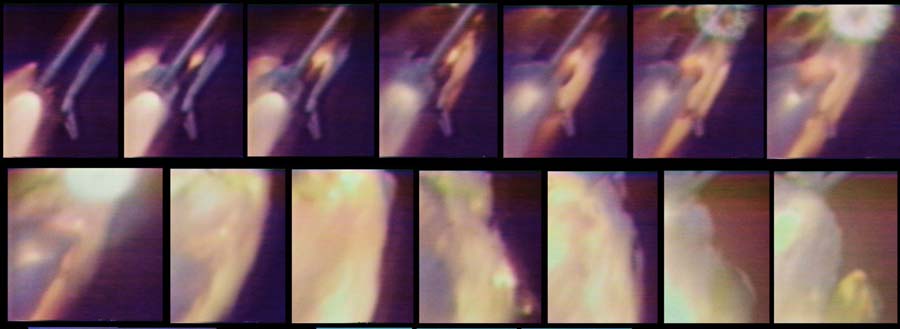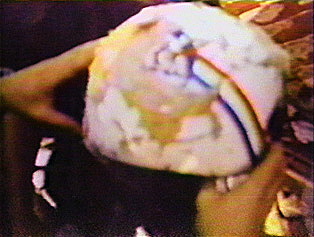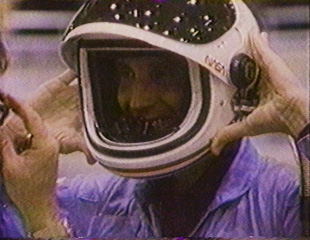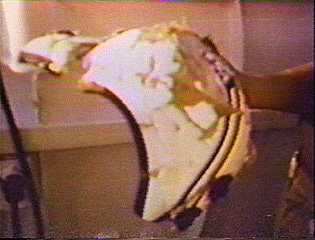

Above: enhanced stills from video of the beginning of the disaster. Top row: The right Solid Rocket Booster (hidden on the the far side of the vehicle) rips itself free from its rear attachment strut and tears into the top of the external tank, disrupting it and mixing the liquid Hydrogen and Oxygen which swiftly ignites. As the bottom dome of the External Tank pops off flames erupt from the hidden side of the vehicle and peek through the gap between the orbiter and the external tank (frames 2-4) with a major 'fireball' then erupting from the top of the external tank (right pair of frames.) Bottom row: the orbiter is veiled by igniting clouds of Hydrogen and Oxygen, with debris emerging and bobbing in and out of sight as in the leading edge of an avalanche. The vehicle breaks up swiftly inside the luminous cloud, with the crew cabin emerging by frame 3. Frames 5 and 6 show the orbiter crew cabin, with some of the forward bottom fuselage still attached, emerging from the fireball. The heat from the briefly burning gases briefly ignites the forward reaction control rocket fuel tanks (last frame)
On January 28, 1986 I learned of the Challenger Disaster from
my wife Cheryl shortly after she happened to tune in the launch
on CNN while channel surfing. We were staying at a friend's house
in Pasadena while I attended the Uranus encounter at JPL. She
awakened me just after the announcement of a 'major malfunction'
and the first thing I saw on the TV was the shot of the parallel
smoke trails being followed by the camera while feedback was gathering
in the NASA audio. I waited impatiently for a video replay, wondering
what happened. When the video tape was shown I saw the initial
'fireball' with the solid rockets flying sideways then ahead,
writhing in their paths like mortally wounded snakes. It was an
apparition slashed across the heavens, a vision of a scorpion
of death. The tail was the initial ascent trail, the legs the
multiple tendrils of debris, and the claws the two wildly careening
solid rocket boosters. The video tape was transfixing, one could
not look away from it, as if some vital clue might emerge with
repeated viewing.

What does one imagine as one tries to make sense of something like this? For this member of the generation reared to worship rockets and space flight, it was like a sacred idol being toppled, a terrible defining moment in a history of space travel which until then was justifiably crowned in repeated triumphs through out my lifetime. It was a part of the brutal graduation from idealism to reality we all face on some level in our lives. From the moment the repeated reruns of the telephoto camera view of the start of the accident were shown I wondered if the crew had time to know what was happening. Everything occurred so fast, and it was was comforting to imagine it was a quick fate for them. Seven people at once are a lot to lose, with many associated families and institutions carrying a shock wave of grief across the space community and beyond. I couldn't imagine being a family member at the VIP stand (which did not have a clear view of the accident from that angle) gradually reading from the terrified crowd reactions the unthinkable, and having this realization shared through television close ups of their faces. And yet seeing this sad image of the parents of Christa McAuliffe on television helped many people 'get in touch with their own feelings' about this tragedy.
At the Jet Propulsion Laboratory the
Voyager Uranus encounter was just winding down, and many journalists
were still gathered at the press area of JPL to see the shuttle
launch over NASA Television. When the ascending vehicle turned
into a fireball there were shouts, then sobs from the crowd in
the Von Karman Auditorium. When I arrived at JPL around noon,
the American flag in front was already at half staff. The press
room was in a state of disarray with many troubled discussions
taking place on what the repercussions of the disaster would be.
At the entrance to the press area were two stacks of press releases,
one for the shuttle mission 51-L and another for the (until then)
imminent Galileo mission. The implications of one to the other
dawned on me as I looked at them, taking one of each for posterity.
For the last few days a direct video link up between NASA headquarters
and JPL had been active during the Uranus encounter. A projection
television in the auditorium beamed images of NASA officials on
a screen while reporters in various NASA centers asked questions,
including from someone sitting near me, who complained after he
was cut off during his question loudly and bitterly about not
getting a straight answer.
The entire day became a numb absorption of news and
other people's reactions. I decided to head home, and while barreling
up the Interstate '5' I listened to radio talk shows commenting
on the tragedy. One radio therapist, answering someone criticizing
Christa McAuliffe for taking such a risk, said no matter how much
sorrow one felt for the crew and their families it was important
to realize that each of them had worked hard to place themselves
exactly where they wanted to be at that moment. How many of us
will be able to say the same thing when our time comes? People
at first thought the crew had vanished instantaneously in an intense
explosion, never knowing what happened, and took comfort from
that. I was encouraged to hear overwhelming support for continuing
space flight. Strange commentary was heard over the next few days
on talk radio, such as people expressing a primitive fear of their
bodies not being intact at death, including the concern that in
order to rise up on resurrection day one needed to be whole!
I heard a story of a woman in her living room screaming
in front of her astonished family that the shuttle would explode
moments before it happened! (this made me wonder how many people
do this during every launch!) Religious broadcasters used the
event to further their agendas, airing stories of spontaneous
school prayers being squelched by the 'Secular Humanists' they
always railed against. Tasteless jokes were passed among school
yards and offices which, while an affront to those close to the
victims, was nevertheless part of the natural healing process.
('What does NASA stand for-Need Another Seven Astronauts' was
among the least offensive)
The deaths of the crew initially seemed instantaneous, with no time to execute any kind of escape option even if one had been built into the vehicle. Early reports suggested that no abnormal telemetry was received before the blast, and early fears were expressed of insufficient clues being available. As the details of the accident emerged the culpability of the Solid Rocket booster, used in wet and cold conditions beyond its design specifications, was revealed. The surprising robustness of the crew cabin under such circumstances was another revelation.
As is well known, the stiff O-ring in the rear of the right Solid Rocket Booster failed and allowed hot gasses to blow through. As time passed a kind of 'slag' actually built up and plugged the leak, and possibly would have held. The Shuttle then passed thrugh a layer of wind shear which flexed the entire vehicle, disturbing the SRB enough to re-open the seam and begin a widening cascade of fire through it. The flame seared the very area the support struts were located, like someone sawing through the branch they were sitting on. The rear support finally gave way and the rear of the long rocket swung out and up, crunching the forward part of the external tank and breaking off the orbiters right wing. From the interior the first visual cue of the event would have been the view out the windows becoming obscured as the ET contents ruptured and briefly ignited around them, followed immediately by the start of a 'nose down' tumble.
The last vocal traces on the tape, "OHoh"
(louder in the first syllable and not separate words, as imitated
by an astronaut who heard the tape) may well coincide with this
or an alarming instrument reading of the plunging external tank
pressure. It is possible what was being said was "Ohhh S--t!",
cut off as electrical connections failed when the breakup of the
vehicle began. Later scrutiny of the tapes and films revealed
the crew cabin, the strongest portion of the vehicle, emerging
from the surging mass of vapor, fairly cleanly detached from the
fuselage. The rest of the vehicle had broken apart like a house
of cards as it tumbled broadside into the resistant air at Mach
1.9. The cabin briefly experienced nearly 20 G's of force, decompression
probably happening at once when cables and surrounding attachment
points were wrenched away. The detached crew cabin tumbled about,
gradually stabilizing in an oscillating nose forward position.
As this took place some of the crew activated their Personal Egress
Air Packs, used for emergency breathing. Since the breakup took
place at 48,000 feet and they were at or above that altitude for
nearly a minute they presumably soon became unconscious in the
thin air and were thus spared the majority of the ordeal.
The crew cabin hit the water 207 seconds after launch
at about 200 MPH on its front left side, indicating a nose down
steep left bank attitude at impact. Attachment struts for the
flight deck seats were found to be bent sharply to the right.
After ocean impact, by the time it settled on the sea floor the
crew cabin had become a flattened heap of loosely consolidated
wreckage, with sonar images such as one by Harold Edgerton shown
in National Geographic Magazine suggesting exposed interior details.
A cockpit window was penetrated by debris but just when that happened
is unknowable. Floating helmets were being salvaged the day after
the explosion. Below right are two images shown during television
coverage in the immediate aftermath of the disaster, presumably
taken clandestinely by a recovery crew member with a small disposable
camera, of recovered helmets from the 51L crew. A complete similar
helmet is shown on the left.



The lessons of that terrible day are
burned into our minds, the images and the reactions. Over the
months much shuttle wreckage was recovered, coincidentally while
across the Atlantic the rusted remains of another pivotal disaster
were being examined, that of the Titanic. Parallels between the
two events occured to me, both were failures of overly trusted
technologies, both had failed to protect the lives of their occupants
by deliberate omission of safety measures in practice or by design,
and both fell victim through miscommunication to a series of preventable
events brought about by cold weather. Both incidents created
in their aftermath wide ranging safety regulations on their respective
forms of travel. One major difference between the two is that
the Titanic sinking was far from the end of ocean travel, while
the Shuttle program thereafter gave up on providing widespread
civilian access to space. The dogged persistence of the backup
teacher, Barbara Morgan, led to her becoming an astronaut and
waiting 21 years to fly. As I write this revision ( 2:35 PM PST
8/14/07) I am watching Barbara participating in the long planned
question and answer session with school children. It is always
great to see a dream fulfilled.
Unlike the Titanic, whose remains and artifacts
were widely seen, Challenger's pieces were packed into a missile
silo and sealed in concrete as if entombing a feared sleeping
demon. A series of freedom of information lawsuits against NASA
were required to pry information from them. Attempts to see the
inside of the cockpit were unsuccessful, although an artist did
manage to force NASA to release some pictures of the outside of
the cabin entombed in scaffolding. Another series of lawsuits
were required to see the transcript of the crew conversations
during ascent which were salvaged from recovered tapes. The reason
given for such reluctance to share information was the feelings
of the families of the crew. While their feelings should be given
rightful consideration this wasn't just their tragedy, the loss
was to the nation as well. Knowing the crew's fate provides greater
understanding of the terrible risks taken by people who ride atop
rockets and assists in making decisions to take such risks. When
interior photos of the charred Apollo 1 capsule were released
it was a sad thing to see and we moved on to land on the Moon.
Now we are fainter of heart, and we recoil from challenges more
than rising to them.
The Challenger Disaster was a mortal blow to the optimistic dreams of widespread access to space such as we still had then. This was the loss of innocence to space fans around the world, and the beginning of the end of the idea that the 'curve' of human numbers going into space would steadily grow until interested individuals could have a good chance of going into space or even to other worlds. The faith we had in technology suffered a deep blow that day, and for a couple of years to come space flight was a memory for the U.S.
Challenger was also the straw that broke
the back of the troubled efforts to build a California shuttle
launch facility in Vandenburg. The French space plane Hermes was
abruptly redesigned to provide a launch escape system, and the
added complexity and weight brought that program a lingering death.
Several advanced 'space plane' concepts were later attempted and
abandoned one after the other by the countries presumably most
capable of such projects because they were either unwilling or
unable to tackle the daunting technological problems. A sense
of diminishing returns in manned spacecraft related progress emerged
in contrast to the limitless dreams of yesteryear. The space station
program began a prolonged troubled gestation with several stillbirths
along the way, at long last ending up with smaller habitats and
fewer people then when the project began. The second Shuttle Disaster
was to further hamper the development of the International Space
Station, for a long time mandating a 2 person crew whose time
was mainly taken up by station maintenance. The Space station
turned out to be little more than a triumph of at least finishing
the project, promises of extensive research opportunities being
conveniently forgotten along the way.
Most of us realized in our hearts after Challenger that we were personally never going to make it into space. At least not through NASA. Writers, artists, and others with connections had been jockeying into position to try to be among the Chosen in a kind of lottery which could have consumed years of many lives unnecessarily. In retrospect many careers were probably redirected to more productive pursuits once a sober appraisal of the odds of going into space was possible. Large government run projects seem to be reaching points of diminishing returns in results obtained for the money spent. Until going into space is as available as say, an expedition to the Himalayas, the impact of Space on our culture will be limited.
Private companies now work to perfect sub orbital
leaps into the fringes of space for paying customers. The next
great leap will be to launch people and cargo to orbit at reasonable
cost. Varied and vigorous work is being done on this front by
companies reaching for ingenious modern solutions to the substantial
problems involved. The last several years have thus been hopeful
ones for seeing a future for human presence in space, even as
Government projects for future manned space flight falter and
collapse one after the other. Earlier versions of this article
ended on a downbeat and even bitter note as the government space
'programs' staggered along. It may well be the dream of human
access to space will some true, just several decades later and
a product of less politics and more clever design work.
It is said to be a noisy environment
inside the shuttle during ascent, but Christa McAuliffe was carrying
her personal micro cassette recorder to capture audio ambiance
during ascent. Journalist Dennis Powell spent some time trying
to track this tape down and was stonewalled by NASA at every turn
of his inquiries. He learned that the tape was recovered, and
was partly wound in the cassette. It was rumored elsewhere that
this tape was supposedly analyzed but revealed no crew related
sounds. The tape was supposedly offered to Christa's widower with
him declining and asking NASA to destroy it. A lurid and wholly
fictitious 'transcript' of the crews final words was published
in a tabloid newspaper.
A possible factor in the accident still poorly researched is the conceivable role of White House pressure in launching in time for a reference to the 'Teacher In Space' in the annual State of the Union speech president Reagan was to give that day. Although this story has been persuasively discredited, until the records or recordings of the relevant discussions between the White House, especially chief of staff Donald Regen, and NASA officials, are released this empty corner of history qualifies efforts to lay this story to rest. Incidentally, when officials interrupted the President's meeting to announce the shuttle had exploded, Reagan asked "You mean the one with the teacher on board?"
*Based on published reports, weighed news group contributions, and private interviews subject to revision as new facts emerge
Revised January 28, 2011